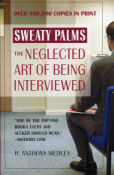| What REALLY goes on in a job interview? Find out in the new revision of "Sweaty Palms: The Neglected Art of Being Interviewed" by Tony Medley, updated for the world of the Internet . Over 500,000 copies in print and the only book on the job interview written by an experienced interviewer, one who has conducted thousands of interviews. This is the truth, not the ivory tower speculations of those who write but have no actual experience. "One of the top five books every job seeker should read," says Hotjobs.com. Click the book to order. Now also available on Kindle. | |
|
Sports Medley: NBA Playoff & U. S. Open Recaps 22 Jun 15 by Tony Medley NBA Playoffs: Whew; they’re over! But the aftermath lingers. Some are asking if this Golden State team is the beginning of a dynasty. In light of what they had just seen, why would anybody ask this question? Golden State was taking on a team that was playing without two of its three best players, Kevin Love and Kyrie Irving, both All-Stars. Cleveland was playing, basically, with two quality players, Lebron James and highly talented, 7-1, 256 pound center Timofey Mozgov. Yet it took Golden State six tough games to win the championship over such an injury–depleted team. This is a dynasty in the making? In 1950 UCLA played Bradley in the quarterfinals of the NCAA basketball tournament. Before the game, young coach John Wooden gave his team an extensive analysis on Bradley’s players and team tendencies. Jerry Norman, who played on the team and later became Wooden’s number one assistant, remembers that, “After listening to Wooden, we thought they were supermen, so we went into the game intimidated. By the time we realized we were better than they were, it was too late and we lost.” Bradley went on to play CCNY in the championship game and lost. UCLA had previously beaten CCNY 60-53 in Madison Square Garden. Norman says, “We were the best team in the nation that year and should have won the championship.” Wooden realized that, too, and never again briefed his team on the other team. His philosophy became, “Just go out there and play our game and we will win.” This is relevant here because Cleveland had a wonderful game plan for the first three games putting into practice former California coach Pete Newell’s dictum, “the team that controls the tempo controls the game,” Cleveland slowed the tempo down substantially in games two and three and won them both, holding Golden State below 100 points each time (93 in overtime and 91 respectively). In each game, James would stand at midcourt dribbling the clock down to 16 seconds before starting the offense. They played a big frontline, controlled the boards, and quickly retreated on defense after taking a shot so that Golden State could not play its wide open running game, forcing the Warriors to play a half-court offense at which they do not excel. However, Cleveland discarded this strategy in game four, “went small,” (even benching Mozgov in game 5!), allowing Golden State to play its up-tempo wide open running game. This resulted in Cleveland losing the next three games as Golden State scored more than 100 points in each of those games. Why Cleveland discarded a winning strategy in midstream is a puzzlement. U.S. Open: There were four compelling stories coming out of last week’s Championship: 1. The Chambers Bay golf course location (apparently built in 2007 for the sole purpose of hosting this tournament) was a disgrace. The fairways were like concrete; the greens like asphalt; the roughs like forests of weeds. Drives that hit on the fairway continued to roll for 100 yards. Approach shots hit the middle of the “greens;” (I use that word advisedly because according to one groundskeeper there were apparently only two blades of green grass on the entire course and they were in different parts of the course) and it was like being on a tilted waxed floor; more often than not the ball rolled forever until it dumped into a trap. If there did happen to be a putt, it bounced and jumped all over the place. Having this as the location for the best golfers in the world to contest a major championship was a travesty. 2. Jason Day played all four days fighting Benign Positional Vertigo (BPV). If you’ve never experienced this, you don’t have any idea what it’s like. I have experienced it and it’s terrible. If you get your head in the wrong position, everything spins. I don’t call athletes heroic (there’s nothing heroic about playing games), but what Day went through and the performance he gave (tied for the lead going into the last day) was almost superhuman. 3. Dustin Johnson missed a 12 foot eagle putt for the win on the 72nd hole. Then he missed a 4 foot birdie putt for the tie. People starting yelling “choke.” But he had been missing short putts all day long. I think he made a poor decision trying to sink the eagle putt for the win. He should have realized that he wasn’t putting well and just put it close, within a foot, so he could sink an easy birdie for the tie and come back tomorrow for an 18 hole playoff. As an aside, Johnson is a good person. His former caddy, Bob Brown, was formerly married to my assistant’s niece, Shana. Even though Johnson and Brown split awhile back, Johnson is paying for Shana’s and Brown’s son’s education at Coastal Carolina University, Johnson’s alma mater. 4. Twenty one year old Jordan Spieth solidified himself as the heir apparent to Jack Nicklaus and a cleaner-living version of Tiger Woods, overcoming a disastrous double bogey on the 71st hole to birdie the 72nd, for what turned out to be the winner.
|
|
|
|
|
